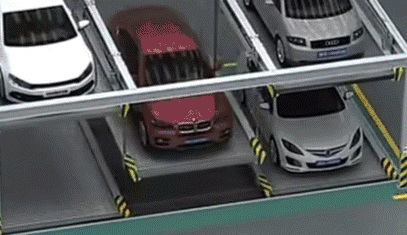In a news report by Epoch Times on August 21, 2025, the once-touted mechanical parking spaces that claimed to “alleviate urban parking difficulties” have been left idle for over a decade, rendering them unusable and difficult to dismantle, ultimately becoming a “pile of debris.” Faced with the challenges of urban parking difficulties and changing demands in mainland China, authorities are struggling to address the issue, highlighting the contradictions between planning and demand.
According to the “2024 China Parking Industry Development White Paper,” mechanical parking equipment has seen a continuous market contraction since 2020, with sales and the number of new parking spaces dropping to less than half of their peak. This white paper was jointly released in June by the Tsinghua University-Tongheng Planning & Design Institute, the China Heavy Machinery Industry Association, and the China Municipal Association’s Urban Parking Professional Committee.
In regards to mechanical parking spaces, netizens have voiced criticisms such as, “This thing was clearly not designed for people to park.” Mechanical parking spaces stipulate that the length of the vehicle should not exceed 5 meters, the width should not exceed 1.85 meters, and the weight should not exceed 2 tons. However, the standard width of regular parking spaces is around 2.5 meters.
Comparatively, mechanical parking spaces are not only significantly narrower but also require precise maneuvering. Any slight deviation would result in the need for wheel hub repairs. “Parking in a mechanical space really makes your palms sweat.”
Over the past few months, the current state of mechanical parking spaces in malls and residential communities across the country has already reflected the bleak prospects of the industry.
Anhui Business News reported that in mid-May, their reporter investigated Park Road No. 1 in the Jiangxi Road and Shilidian Road intersection in Hefei City, where a large number of three-story automated parking spaces remained largely unused, with the upper two floors already covered in dust and some filled with miscellaneous items.
Residents stated, “There are more than 2,000 households in the community, but the actual usable parking spaces are under 1,000, leading to a contradiction of overcrowded regular parking spaces and abandoned mechanical parking spaces.”
A similar situation was observed at the Xingye Jun luxurious courtyard on the North Second Ring Road of Hefei. Mechanical parking spaces had accumulated dust over the years, with the controllers powered off. Residents preferred to park their cars in the passageways rather than using the “narrow and prone to scratches” mechanical spaces.
Why not simply dismantle them? The Owners’ Committee explained that these parking spaces are fixed assets of the developers, and dismantling them involves complex procedures and compliance risks. Moreover, upon dismantling, they may no longer meet the original planning standards, resulting in a double bind of being “undismantlable and unusable.”
Citing the “China Parking Industry Development White Paper,” experts pointed out that the root of the problem lies in the early construction phase where many developers, aiming to meet parking ratio requirements (some cities mandate 0.4 parking spaces per 100 square meters in shopping malls and a minimum of 0.7 spaces per household in residential areas), extensively utilized lower-cost mechanical parking spaces without subsequent investment in maintenance.
Mechanical parking spaces are specialized equipment that require biennial inspections, specialized operation, and regular maintenance. If left idle for an extended period, the equipment may deteriorate beyond repair, leading to significant costs for reactivation and insurance. Disputes over “who bears the costs” and “who receives the profits” often arise among homeowners, developers, and property management companies, with numerous communities in Anhui currently embroiled in litigation over similar issues.
In response to these lingering issues, several regions have started adjusting their policies. Hangzhou’s new implementation details for the “Urban Construction Engineering Parking Lot (Garage) Setting Rules and Allocation Standards” explicitly state that residential properties are not allowed to use mechanical parking spaces. Commercial properties cannot exceed a 30% allocation, and other structures should not exceed 50%.
However, not all mechanical parking spaces have been left neglected. According to Anhui Business News, the Modern Mingyuan Community on Xiyu Road in Hefei, after years of disuse, managed to refurbish and reactivate over 600 parking spaces in 2019 with a million yuan raised by the homeowners as the number of vehicles increased. The Chairman of the community’s Owners’ Committee stated, “Maintenance, specialized inspections, insurance, and labor costs are shared among the car owners, fair and transparent, and everyone is willing to cooperate.”
Such successful cases indicate that the key lies not in the technology itself but in the subsequent management and benefit distribution mechanisms.
Industry experts suggest that for existing mechanical parking spaces, decisions to dismantle or refurbish them should be made through resolutions passed in the homeowners’ meetings as per the Civil Code and approved by relevant departments. Simultaneously, incentivizing the introduction of intelligent vertical parking garages and other innovative solutions accommodating the trend of new energy vehicles and wider vehicle sizes is essential.
As new energy vehicles become more prevalent and vehicle dimensions and charging requirements change, the question arises: should these idle steel structures of the past decade be completely phased out, or can they be revitalized through technological improvements?
The failure of mechanical parking spaces is no longer just a parking issue; it is a microcosm of the disconnection between urban planning and actual demand in China’s urbanization process.

